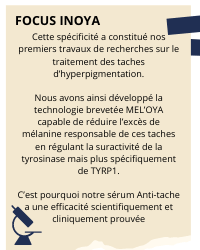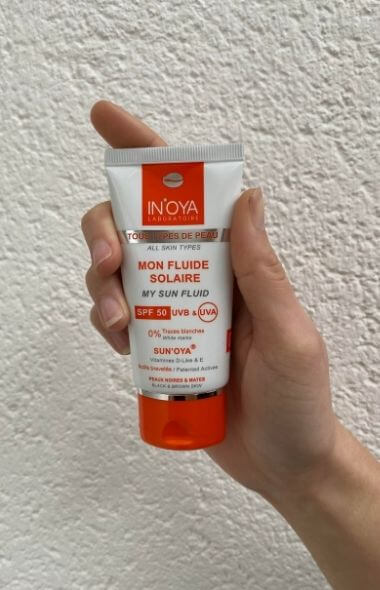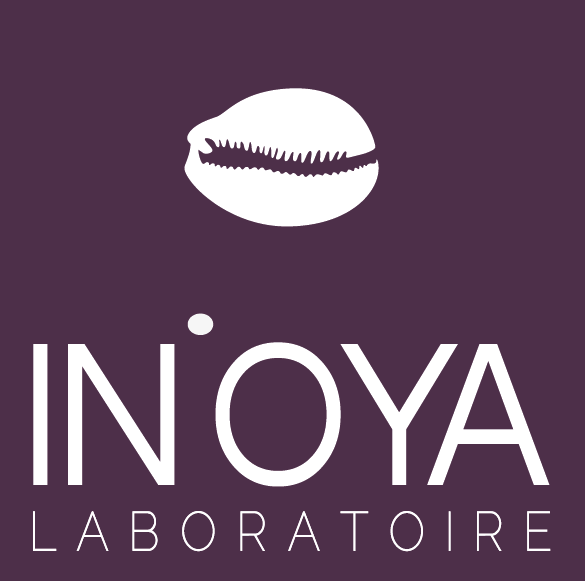Author : Co-authored with Dr. Traoré, Dermatologist in Guinea.
 Albinism is a rare, non-transmissible and hereditary recessive disease. Present all over the world, it affects all types of individuals regardless of their gender or origin.
Albinism is a rare, non-transmissible and hereditary recessive disease. Present all over the world, it affects all types of individuals regardless of their gender or origin.
It is caused by a set of genetic mutations affecting melanogeny. Affected individuals have an abnormal number of melanocytes and are commonly unable to produce Eumelanins (brown/black pigment) and Pheomelanins (Yellow/Orange). This depigmentation mainly gives albinos a very light skin color, white hair and blue eyes.
In reality, there are different subtypes of Albinism including two : Oculocutaneous Albinism type 2 and 3 which are very specific to black, matte and mixed skin. This article will allow you to understand the distinction between an albino of European and African origin. Know their care and the possible complications related to their disease but also to realize and understand the persecution of albinos in Africa.
What are the different types of Albinism ?
Albinism is a broad disease grouping different subtypes and syndromes related to it. Their classification is carried out according to the different genes affected, their clinical consequences and the severity of the disease.
The 4 major types have been identified :
-
- Oculocutaneous albinism type 1 is the most serious. It is caused by a mutation in tyrosinase. Affected subjects have white skin and hair and blue eyes. It is the most serious form because they are the only ones to have a total absence of melanin during their lives.
- Oculocutaneous albinism type 2 is caused by the mutation of the AOC2 gene encoding the p protein. Affected subjects have light brown hair and skin. Their iris is gray.
- Oculocutaneous albinism type 3 or Roufus/Roux is caused by the mutation of the AOC3 gene encoding the enzyme TYRP1. Affected subjects have coppery skin, red hair and a brown iris.
- Oculocutaneous albinism type 4 is caused by the mutation of the SLC45A2 gene encoding the MATP protein.
What is the specificity of albinos of African origin?

The frequency of appearance of different subtypes of Albinism is different depending on the affected populations. Oculocutaneous albinisms type 2 and 3 are very present in Africa. The prevalence of AOC 2 is 1/500 in an African population compared to 1/40000 in Europe. That of AOC 3 is 1/8500 in Africa and is considered rare elsewhere.
These tyrosinase-positive albinisms are more apparent in subjects with pigmented skin because their mutations cause structural and/or functional changes in key mechanisms of eumelanin synthesis (initially the majority in this type of person)
- For AOC 2 : It is the p protein that is mutated. This impacts the proper transport of tyrosine and tyrosinase to the place of action of melanogenesis. It also modifies the formation of melanosomes by disrupting their intraluminal pH. This alters the eumelanin-pheomelanin balance.
- For AOC 3 : It is the tyrp1 enzyme that is mutated. Being one of the main enzymes in the synthesis of eumelanins, this directly influences the pigmentation of people with pigmented skin.
Thus, albinos of African origin have genetic and therefore clinical specificities different from subjects of Caucasian origin. They are therefore not identical.
What are the complications of Albinism ?
Albinism is responsible for various complications :
- Skin: The skin becomes thicker and rougher. It may appear actinic keratoses (red and crusty lesions), spots of hyperpigmentation, telangiectasias (dilation of small vessels). More serious is the high possibility of developing skin cancers such as basal cell carcinomas or squamous cell carcinomas. In rare cases, the appearance of melanomas occur most often on non-photoexposed areas.
- Ophthalmics : Albinism is responsible for the 5-10% of visually impaired people in the world. This is caused in part by the possible appearance of Nystagmus (repeated and involuntary movements of the eyes most often horizontal) or strabismus (non-aligned eyes). In addition, photophobia (intolerance to light) is very common in albino subjects.
- Daily adaptation: Albinos are doomed to never drive because of their visual impairment. It also leads to delays in school education and a real lack of professional opportunities. They are very limited people.
What is the management of Albinism ?
Apart from melanin-related disorders, subjects with albinism have the same skin characteristics as normal skin. Thus, on a daily basis, it will be important for them to determine their skin types and their possible skin problems (hyperpigmentation spots, acne or eczema) in order to provide their skin with a care protocol specific to their needs.
However, the appearance of skin and visual complications of albinos being frequent, they require regular medical care and even surgical in some cases. The following actions are therefore necessary in order to limit their appearances:
- Ophthalmological consultations to avoid eye complications.
- Dermatological consultations to treat pre-malignant and malignant skin lesions.
- The daily use of emollient care to calm skin inflammations.
- The daily and repeated application every two hours of UVA UVB sunscreens index 50.
- Avoid exposure to the sun if possible between 12pm-4pm because during this period, UV rays are the most active and dangerous.
- Wearing wide-brimmed hats, long-sleeved shirts, trousers and sunglasses are strongly recommended to protect yourself as much as possible from UV rays.
- Drink at least 2 liters of water a day to avoid dry skin.
 Why is the sun Albinos ' number 1 enemy?
Why is the sun Albinos ' number 1 enemy?
The ultra-violet rays of the sun are very dangerous for a subject with Albinism.
Melanin is responsible for skin pigmentation but it also has a photoprotective role. It protects the nuclei of keratinocytes from the harmful effects of the sun's UV rays. Indeed, in contact with the skin, they create free radicals responsible for the appearance of burns (sunburn), skin dehydration, hyperpigmentation spots, actinic keratoses, the accentuation of skin aging but also genetic mutations causing skin cancers.
It has been proven that people with black, matte and mixed skins, by their high concentration of Eumelanins, have a natural sun protection of index 15. Hence their lower sensitivity to the sun than Caucasian skin.
On the other hand, the skin of subjects with albinism being totally deficient in melanin or possessing very little, their skins are very sensitive and vulnerable to these radiations. That is why they develop so many skin complications. The sun is therefore a real danger for albinos, especially in Africa. Thus, it is very important for them to protect themselves effectively, by applying sunscreen, clothing if possible anti-UV etc.
Violence and discrimination of Albinos in Africa: what about today ?
Generally in Africa and particularly in Guinea, people living with albinism are victims of stigma and discrimination in society. Awareness-raising, information and scientific knowledge sessions on the phenomenon of albinism have greatly contributed to improving the quality of life of albinos in Africa.
Of course, efforts must be made, but most of the false beliefs about albinos are being abandoned by society. However, rape, ritual death and trade in the organs or limbs of people living with albinism is still relevant in Guinea and Africa in general.
There are many centres today designed to bring together people with albinism, including children who are orphans or who have been assaulted. Their goal is to provide them with a safe environment and easier access to education and care.
We understand thanks to this article that there is a real genetic and thus clinical distinction between an albino of African and Caucasian origin. That said, the precautionary gestures and their management in the face of these various complications are identical. In France, the Genespoir association was created to support Albinos on a daily basis. Dr. Traoré, a dermatologist in Conakry (Guinea) is also setting up awareness days to educate albinos about the appearance of various possible complications and distribute solar fluids.


